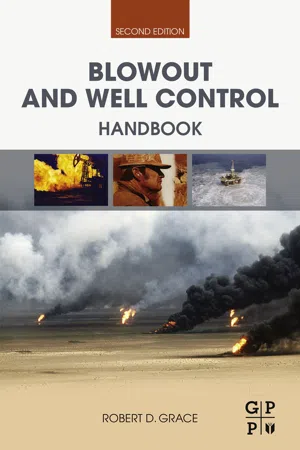
- 472 pages
- English
- ePUB (mobile friendly)
- Available on iOS & Android
Blowout and Well Control Handbook
About this book
Blowout and Well Control Handbook, Second Edition, brings the engineer and rig personnel up to date on all the useful methods, equipment, and project details needed to solve daily well control challenges. Blowouts are the most expensive and one of the most preventable accidents in the oil and gas industry. While some rig crews experience frequent well control incidents, some go years before seeing the real thing. Either way, the crew must always be prepared with quick understanding of the operations and calculations necessary to maintain well control.Updated to cover the lessons learned and new technology following the Macondo incident, this fully detailed reference will cover detection of influxes and losses in equipment and methods, a greater emphasis on kick tolerance considerations, an expanded section on floating drilling and deepwater floating drilling procedures, and a new blowout case history from Bangladesh. With updated photos, case studies, and practice examples, Blowout and Well Control Handbook, Second Edition will continue to deliver critical and modern well control information to ensure engineers and personnel stay safe, environmentally-responsible, and effective on the rig.- Features updated and new case studies including a chapter devoted to the lessons learned and new procedures following Macondo- Teaches new technology such as liquid packer techniques and a new chapter devoted to relief well design and operations- Improves on both offshore and onshore operations with expanded material and photos on special conditions, challenges, and control procedures throughout the entire cycle of the well
Frequently asked questions
- Essential is ideal for learners and professionals who enjoy exploring a wide range of subjects. Access the Essential Library with 800,000+ trusted titles and best-sellers across business, personal growth, and the humanities. Includes unlimited reading time and Standard Read Aloud voice.
- Complete: Perfect for advanced learners and researchers needing full, unrestricted access. Unlock 1.4M+ books across hundreds of subjects, including academic and specialized titles. The Complete Plan also includes advanced features like Premium Read Aloud and Research Assistant.
Please note we cannot support devices running on iOS 13 and Android 7 or earlier. Learn more about using the app.
Information
Equipment in Well Control Operations
Abstract
Keywords
Pressure, Erosion, Corrosion, and Vibration
Pressure
Vibration
Table of contents
- Cover image
- Title page
- Table of Contents
- Copyright
- Preface
- Acknowledgments
- Chapter One: Equipment in Well Control Operations
- Chapter Two: Classical Pressure Control Procedures while Drilling
- Chapter Three: Pressure Control Procedures While Tripping
- Chapter Four: Special Conditions Problems and Procedures in Well Control
- Chapter Five: Fluid Dynamics in Well Control
- Chapter Six: Special Services in Well Control
- Chapter Seven: How to Drill a Relief Well
- Chapter Eight: The Underground Blowout
- Chapter Nine: Case Study: The E. N. Ross No. 2
- Chapter Ten: Contingency Planning
- Chapter Eleven: The Al-Awda Project: The Oil Fires of Kuwait
- Epilogue
- Index
